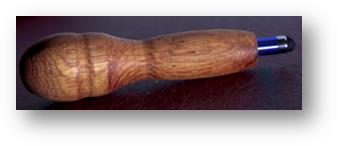What is a stylus? What is a capacitive stylus? Do we even need one? Let’s ask Steve Jobs. Going back to 2007, Steve always thought we didn’t need a stylus when we could use any one of our ten fingers. Why? He thought we would lose them (we do), he thought it wasn’t natural (it  isn’t), he thought we should use the best pointing device in the world – our finger (he was right). However, there are many applications that just feel better with a stylus that feels like a pen, a pencil or a brush. I have a number of styli (plural for stylus).
isn’t), he thought we should use the best pointing device in the world – our finger (he was right). However, there are many applications that just feel better with a stylus that feels like a pen, a pencil or a brush. I have a number of styli (plural for stylus).
But I set out to create my own unique stylus. I wanted something heartier, heavier and comfortable to hold. Pictured here is the utensil I created from an old tree I found in the back yard, my lathe and an old metal stylus I had laying around. Along the way, I discovered the science behind a capacitive stylus required for capacitive sensing screens like iPad’s and iPhones. Creating a capacitive stylus requires that the tip of the stylus transfer the static electricity from a person’s hand to the sensors on the screen. In essence, it needs to conduct electricity. So how did my primitive custom stylus work out? Not so hot. If my fingers were close to the metal stylus tip, it worked great. If I held this device on its end away from the tip, it did not work at all. Solution? Wrap the entire wooden object with aluminum foil. That worked great — until the aluminum foil tore or just fell off in which case I was back to square one. You see, wood is not a good conductor of electricity. Who knew that was important!
So I am heading back to the drawing board searching for a wood like product that can be molded but also conducts electricity. Stay tuned!
